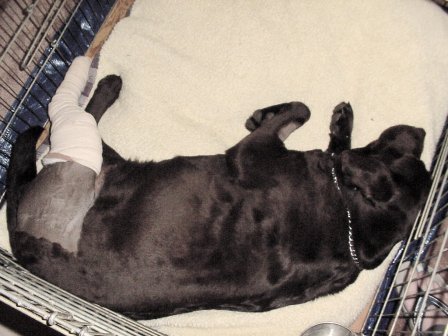

We had nearly a month of constant rain this winter. The dogs (and we) were in sorry need of freedom. The rain stopped, and a week later, we had a day that rivaled any beautiful spring day. The time had come. I opened the kennel doors for the girls, and gave them the freedom to run that they were longing for. They exploded from their kennels as if they had been shot from a cannon. In typical Labrador manner, they body slammed each other and raced around the kennel. It took only moments to realize that one of them had been injured in the 14 dog body-slam. Whisper hadn't made a sound when it happened, but she emerged from the pack on three legs, holding one up off the ground, and unable to put weight on the leg. The above photo above was taken literally three minutes before she had been let out to run. Poor Whisper... if only I could just take back those few minutes and rethink the energy that would result from opening all the kennels at once. In over 20 years of owning dogs, this was the first dog we'd have to have ACL surgery on. It's expensive, as all Orthopedic surgeries are, and all an owner who loves their dog can do, is gulp hard and have the surgery done. The longer the unstable knee goes untreated, the more irreversible arthritic changes occurr, and less satisfactory outcomes result from the delay of surgery.
 The most commonly
seen injury in active dogs is a torn ligament in the knee. Dogs
have the same bones and ligaments forming their knee joint as
people do and they can suffer the same type of injuries. One of
these ligaments, the anterior cruciate ligament (ACL) is the structure
that is most frequently damaged. This is a common injury in football
players, skiers, and other human athletes. Damage to the ligament
occurs when the knee is twisted during weight-bearing or when
the knee is hyper extended. In sporting dogs, the mechanism of
injury is similar and this can occur in the field during strenuous
activity. Dogs may also suffer a torn ligament during routine
activities such as retrieving. An injured dog may, or may not,
cry out at the time of injury. They will usually hold up the affected
hind leg. Inability to use the leg is typical of a complete tear
of the ligament. A partial ACL injury can also occur. In this
chronic condition, the ligament becomes damaged over a prolonged
time without a major traumatic event. These dogs tend to experience
episodes of lameness that worsens after exercise. The result of
traumatic or chronic lagament injury, is instability within the
knee joint. This instability results in pain and lameness, with
the possibility of arthritis in the future.
The most commonly
seen injury in active dogs is a torn ligament in the knee. Dogs
have the same bones and ligaments forming their knee joint as
people do and they can suffer the same type of injuries. One of
these ligaments, the anterior cruciate ligament (ACL) is the structure
that is most frequently damaged. This is a common injury in football
players, skiers, and other human athletes. Damage to the ligament
occurs when the knee is twisted during weight-bearing or when
the knee is hyper extended. In sporting dogs, the mechanism of
injury is similar and this can occur in the field during strenuous
activity. Dogs may also suffer a torn ligament during routine
activities such as retrieving. An injured dog may, or may not,
cry out at the time of injury. They will usually hold up the affected
hind leg. Inability to use the leg is typical of a complete tear
of the ligament. A partial ACL injury can also occur. In this
chronic condition, the ligament becomes damaged over a prolonged
time without a major traumatic event. These dogs tend to experience
episodes of lameness that worsens after exercise. The result of
traumatic or chronic lagament injury, is instability within the
knee joint. This instability results in pain and lameness, with
the possibility of arthritis in the future. 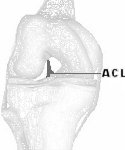
Veterinary examination of a dog with a torn ACL will usually reveal a swollen, painful knee joint. Dogs with chronic knee instability tend to develop scar tissue, which appears as a firm swelling on the inside of the affected knee. It is important for the vet to determine a chronic vs traumatic condition, as often this will determine which type of surgical repair he/she will employ. X-rays are used to support the diagnosis and to document any arthritic changes in the joint. The most reliable means of diagnosing this injury is to move the femur and tibia in a certain way to demonstrate the instability. This movement is called a "drawer sign." When a veterinarian elicits a positive drawer sign, the lower bone of the knee joint (tibia) is moved forward relative to the upper bone (femur). Simply said, the femur slides backwards on the tibia.
We were lucky. Whisper only had to have imbrication of the joint (sutures around the medial and lateral aspects of the femur, down through a drill hole in the tibial tuberosity), which is the least costly of the repair methods (and can only be used if there is no chronic condition (with resulting arthritic changes). Sometimes, along with imbrication, the vet will further stabilize the joint with a procedure, where the patellar tendon is used as graft material. The most expensive of the repairs, the most commonly employed, and the one that is necessary if there is any pre-existing arthritic changes is calld a Tibial Plateau Leveling Osteotomy ( TPLO ).
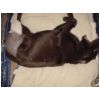 Good
Morning, Whisper --yawn 123.61 KB |
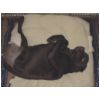 Are
you comfortable enough? Nice looking turkey leg you have there! 119.16 KB |
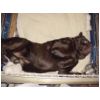 Can
I fluff your pillow? Surgery is hard! 127.29 KB |
Strict limitation of activity is employed after surgery. The dog should be crated. External support of the knee is common following surgery in order to protect the repair during the early healing process. A padded bandage or light splint is used for no more than a week or two after surgery. It is expected that Whisper will wear her bandage for five days. We are not to get it wet, or it will need immediate changing. Whisper has some trouble voiding without it getting close to the dressing, or the puddle running into it, so we bag up the dressing when she goes out to potty. All walking and potty is done on leash to prevent any possibility of her injuring the newly repaired leg.
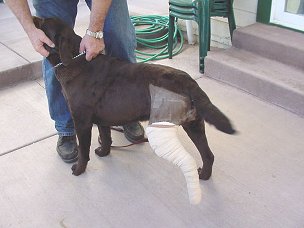 Assistance up and down steps is mandatory. |
 Going potty is a major effort |
